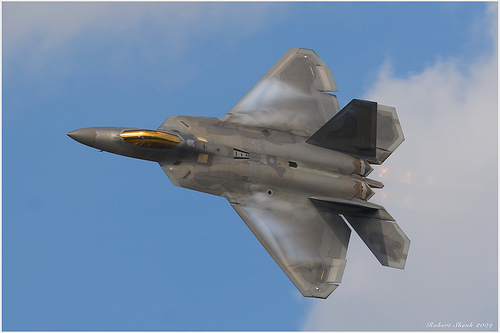Remember the F-22 Raptor?
You’d be forgiven if you don’t, as the stealth fighter jet built by Lockheed Martin in the 1990s was a colossal failure by almost any measure.
Not only did the F-22 cost upwards of $137 million per jet — more than any other jet in history — but the pilots have been repeatedly deprived by oxygen and nearly killed because of faulty engineering. As a result, only 196 of the originally proposed 500 jets were actually built.
Such is the plane that Republican presidential candidate Mitt Romney wants to start building again, and, big surprise, Lockheed agrees with him.
“I think the idea of shrinking our military to try to get closer to the budget is the wrong place to look,” Romney said in Virginia on Saturday. “I would add more F-22s and add more than 100,000 active duty personnel to our military team.”
As Wired Magazine pointed out, restarting the F-22 production line is very unlikely, and even longtime Lockheed advocate Loren Thompson of the Lexington Institute outlined the many expensive obstacles.
The current next-generation fighter jet under production, the F-35 Joint Strike Fighter, has plenty of its own problems, as the Weekly reported in a cover story this summer, but the F-22 is arguably even worse.
With $500 billion in defense cuts looming if Congress doesn’t find other places to cut from the federal deficit, Romney’s suggestion to start building more F-22s is out of touch at best and downright ludicrous at worst, especially when the military has already chided Lockheed for its failure to keep costs down on the F-35.
Add to that the evidence that defense spending yields a poor return on job creation, and it’s hard to understand how anyone could argue for more defense money during a deep, lasting recession caused by two foreign wars more than anything else.













You must hate America. I hope you’re proud. Move to China, dooshbag.
Congrats on your 3rd grade level journalism paper. I’m sure MSNBC will be calling soon…
Tom, you are not very well read or very misinformed to make a comment like that. Click on the links before you call someone out. Man oh man.
Author doesn’t seem to want to address the hypoxia issues of the Raptor in more than the most superficial way. The real problem of this airplane, in short form, is that it has such impressive kinematic performance that it flies in uncharted territories for human tolerance. NASA is still trying to assist the Air Force in figuring out what the problem is. It doesn’t appear to be faulty equipment – it’s that this fighter can subject its pilots to more than their bodies can take, and the life sciences knowledge is trying to catch up, in determining parameters for the g-suit, pressure breathing, and oxygen supply.
I’m not saying that we should build more Raptors – I think it’s a bad idea, and SecDefs under both Obama and Bush agreed (it’s too costly, and not multipurpose enough), but an inaccurate hackjob on the airplane’s capabilities and the engineers who designed it is not the best way to make your point.
And, by the way, the decision to terminate Raptor production happened before the hypoxia issues, and was due to being unable to procure more fighters under a cost cap due to high fixed costs, not because of the hypoxia problems. Your article would look more like journalism and less like a hit piece if you got your facts straight.
@ Zippy
“I’m not saying that we should build more Raptors – I think it’s a bad idea, and SecDefs under both Obama and Bush agreed (it’s too costly, and not multipurpose enough), but an inaccurate hackjob on the airplane’s capabilities and the engineers who designed it is not the best way to make your point.”
Going ahead with the F-35 JSF (Just So Failed) is a terrible idea.
Why?
Because its a failed project, the biggest and ugliest, by far, of all time.
Participating the program and procuring 2,443 aircraft is a really a terrible idea at the first place. It’ll be inadequate to deal with the changed threat environment, and if you have the F-35s that just aren’t capable of dealing with the high threat zones, it just doesn’t do you any good of going ahead with the failed program and sink the money. Because the F-35 will be increasingly expensive aircraft that will fail the air defence program and there’s absolutely no point of sticking with the F-35 because some hostile nations could well be purchasing The Nebo M Mobile “Counter Stealth” Radar, advanced S-400 and S-500 SAM systems.
The 55Zh6M Nebo M “Counter Stealth Radar”. If you want to find out more about this counter stealth radar, here’s a description if you’re interested.
Development initiated late 1990s leveraging experience in Nebo SVU VHF-Band AESA radar;
2012-2013 IOC intended;
Designed from the outset to detect stealth fighters and provide early warning and track data to missile batteries and fighters;
The VHF component will provide a significant detection and tracking capability against fighter and UCAV sized stealth targets;
High off-road capability permits placement well away from built up areas, enabling concealment;
Rapid deploy and stow times permit evasion of air attacks by frequent movement, defeats cruise missiles like JASSM;
Initial Nebo M builds for Russian Air Defence Forces, but expected like other “counter-stealth” radars to be marketed for global export to arbitrary clientele.
The VHF band element in that radar will detect the F-35 at a distance of tens of miles. That is without a doubt. What that means is that the aircraft is going to be in great difficulty if it tries to deal with what I call a modern or contemporary threat. The same is also true when you deal with these newer stealth fighters, because they are designed to compete with the F-22. They fly higher; they are faster and more agile—much, much more agile. They have more powerful radars and much, much better antenna packages for other sensors. The F-35 is not meeting its specifications and its specifications are inadequate to deal with the changed environment.
If the F-35 was to be able to meet its specifications, the aircraft will have the ability of going up against a 1980s Soviet air defence system of the type that we saw destroyed very effectively in Libya 12 months ago, the F-35 would be reasonably be effective in that environment, because these older Soviet radars would not see it.
But if you are putting F-35 up against the newer generation of much, much more powerful Russian radars and some of the newer Chinese radars, the aircraft is quite detectable, especially from behind, the upper side and from the lower sides as well.
Also F-35 will also be detected by the L-Band AESA. It is used for targetting which they’ll be able to track LO/VLO stealth planes such as the F-35 especially from behind, the upper side and from the lower sides as well. Unfortunately the exhaust nozzle of the F-35 will be extremely hot. The back end of the F-35 in full afterburner is something like 1600 degrees (Fahrenheit). In terms of temperature, aluminium combusts at 1100. You are talking about something really, really hot. If you have got a dirty big sensor on the front of your Su-35S or your PAK-FA or whatever, it lights up like Christmas lights and there is nothing you can do about it. And the plume, because of the symmetric exhaust, is all over the place. It is not shielded, it is not ducted in any useful way. The Sukhois will be able to seek and destroy the F-35 when using the heat seeking BVR AA-12 (R-77) Adder AAMs.
This has shown that the aircraft has a lot of limitations and it cannot do a lot of things as expected to show and promise that is a true fifth generation fighter, because it does not meet all the requirements of partner nations. Its fuselage is too overweight which has too much cross section; the wings are too small which lacks the extreme manoeuvrability. The wing planform is optimised for subsonic cruise and transonic manoeuvre which doesn’t provide enough lift and drag to defeat Beyond Visual Range (BVR) and Within Visual Range (WVR) air-to-air missiles (AAMs) from enemy fighters in the dogfight and stand-off ranges, advanced surface-to-air missiles (SAMs) and ground fire during top end threats. It also has inferior acceleration at Mach 1.6, short range with no loiter time and very limited weapons payload that is unsuited for bomber and cruise missile defence and totally unsuited for air superiority role when compared against Sukhoi family, upcoming J-20 and perhaps the J-60 of aircraft, particularly post 2010 configurations; definitely post 2015 evolved growth variants.
The APG-81 AESA radar. The nose geometry of the F-35 limits the aperture of the radar. This makes the F-35 dependent on supporting AEW&C aircraft which are themselves vulnerable to long range anti-radiation missiles and jamming. Opposing Sukhoi aircraft have a massive 1 meter radar aperture enabling them to detect and attack at an JSF long before the JSF can detect the Sukhoi. It has Medium Power Aperture (0) (Detection range around 140 – 150 nm at BVR)
Compared to which other aircraft’s radar?
The N011 Irbis-E (Snow Leopard) for the Su-35S Super Flanker-E
NIIP claims a detection range for a closing 32.3 ft² (3 sq.m) coaltitude target of 190 – 250 NMI (350-400 km), and the ability to detect a stealthy aircraft while closing 0.11 sq.ft (0.01 sq.m) target at ~50 NMI (90 km). In Track While Scan (TWS) mode the radar can handle 30 targets simultaneously, and provide guidance for two simultaneous shots using a semi-active missile like the R-27 series, or eight simultaneous shots using an active missile like the RVV-AE/R-77 or ramjet RVV-AE-PD/R-77M.
The PAK-FA will feature the N050 BRLS IRBIS AFAR/AESA?, similar to the Su-35S N011.
* Frequency: X-Band (8 – 12 GHz)
* Diameter: 2 ft 4 in (0.7 m)
* Targets: 32 tracked, 8 engaged
* Range: 248 mi (400 km)
EPR: 32.3 ft² (3 m²): 99.4 mi (160 km) and 0.11 sq.ft (0.01 sq.m) target at ~50 NMI (90 km)
Azimuth: +/-70°, +90/-50°
* Power: 4,000 W
* Weight: 143 to 176 lb (65 to 80 kg)
Again, the F-35 will be detectable from behind the fuselage, the upper side and from the lower sides as well, except for the front area, a conservative estimate for the frontal RCS of the F-35 would be 0.0015 square metre which is only stealthy in the front, this is what I call “Partial Stealth” which the F-35 does have. Because if the situation arises, the Sukhoi family of fighters, upcoming J-20 or J-60 can out-run, out-climb and out-manoeuvre, and be able to track the F-35 using L-band AESA, IRST sensor (from the upper and lower sides and aft fuselage) and launch their AAMs from any altitude at speed etc.
The bad news is, with the changed environment the F-35 will be obsolete when the aircraft arrives in 2018 or later, the US as well the allies are armed with this aircraft will make their air power totally ineffective in the next 30 to 40 years. I’m complaining about LM lying and misleading to the military and the public what they state their facts what the F-35 can do etc etc. And I don’t see any contradiction with the way I’ve promoted these new Russian/Chinese radars etc.
The F-35 is a boondoggle 5th Generation Failure
@ Zippy
When you made those statements saying restarting the F-22 production line is a bad idea, and SecDefs under both Obama and Bush agreed (it’s too costly, and not multipurpose enough), but an inaccurate hackjob on the airplane’s capabilities and the engineers who designed it is not the best way. I strongly disagree.
The F-22 is the only 5th generation fighter that can do the job far better than the lemon F-35. Because
#1 – Survival In Combat Against Modern Weapons
Proliferation of Advanced High Technology Missiles and Aircraft
Since the end of the Cold War, the Russian and Chinese defence industries have absorbed most of the advanced technology in the globalised market. The most recent generation of radars, Surface to Air Missiles and fighter aircraft they have developed can produce air defence systems which are completely impenetrable to all United States combat aircraft other than the F-22A Raptor and B-2A Spirit. The new stealthy Sukhoi PAK-FA directly challenges the F-22A Raptor. The result of this is that the United States will lose access to many theatres of operation on the global stage, as these new weapons proliferate, unless the United States deploys ~700 F-22A Raptors – the number originally planned for in the first place.
#2 – There Are NO Alternatives to the F-22 Raptor
The Lemon F-35 Just So Failed is NOT a Substitute for the F-22 Raptor
The widely held view in Western bureaucratic circles, that the F-22 and F-35 are interchangeable aircraft, is not true and can never be true. The F-22 provides close to three times the capability of the F-35 at a similar unit procurement cost. The F-35 lacks the performance of the F-22, the survivability of the F-22, the firepower of the F-22, and the deployability of the F-22. The limitations of the F-35 are inherent in its basic design and cannot be fixed by design modifications or upgrades. Poorly defined basic specifications for the F-35 and inadequate prototyping have resulted in an expensive aircraft which cannot be used in combat situations other than benign, requires support by a lot of F-22 Raptors and aerial tankers, and requires long concrete runways for overseas deployments.
The F-22 is the only viable combat aircraft design left in the Western world, following the emergence of the T-50 PAK-FA and J-XX/J-20 stealth fighter designs. Further evolution of the F-22 series and the development of derivative designs is the only path left for US air power which can produce viable numbers of viable designs in a reasonable timeline.